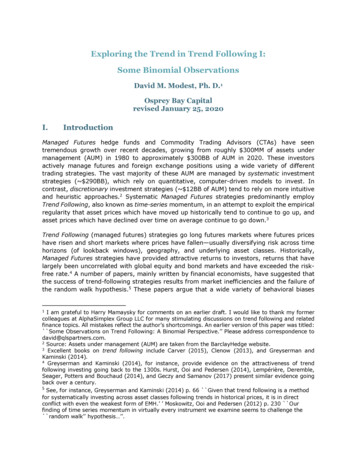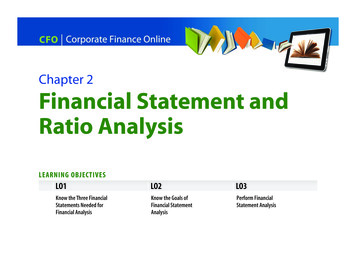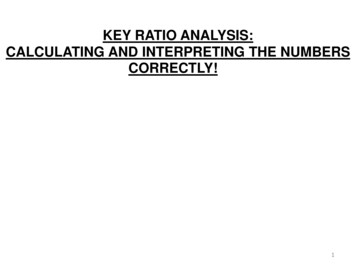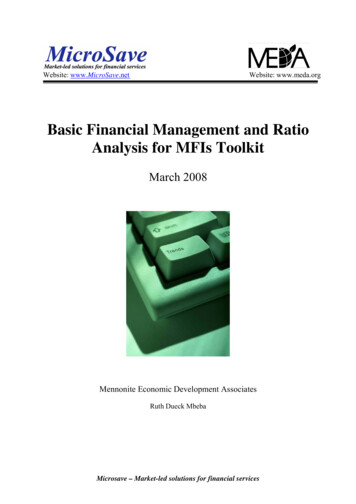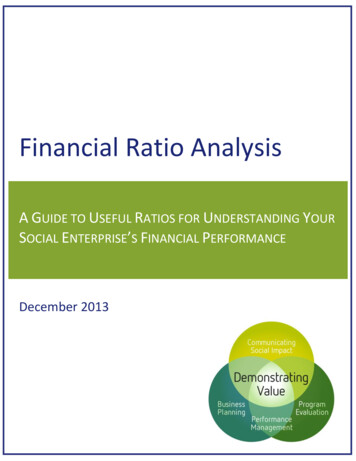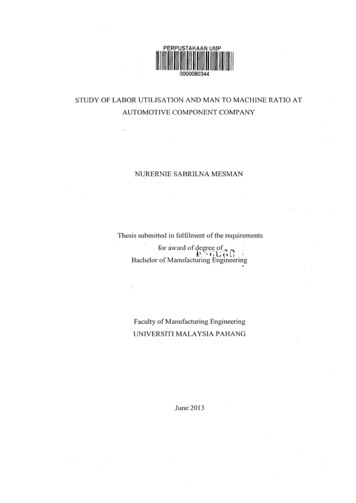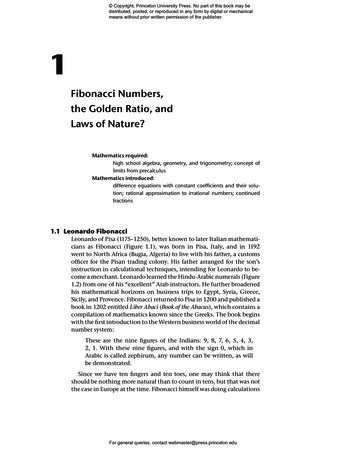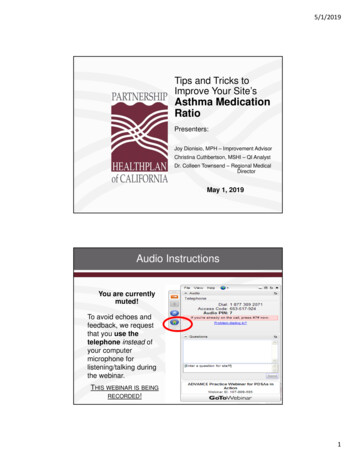
Transcription
COURSE 6BLOCK 2UNIT-1RATIO ANALYSIS AND TREND ANALYSISLearning ObjectivesAfter reading this chapter, students should be able to: explain the meaning and objectives of accounting ratios Identify the various types of ratios commonly used Calculate various ratios to assess solvency, liquidity, efficiency andprofitability of the firm Elaborate the use of trend analysis in analyzing financial statementStructure1.1Introduction1.2Meaning of financial ratios1.3Procedure for computation of ratios1.4Objectives of ratio analysis1.5Types of ratios1.6Profitability ratios1.7Liquidity ratios1.8Activity ratios1.9Solvency ratios1.10Advantages of Ratio analysis1.11Limitations of Ratio analysis1.12Trend Analysis1.13Let’s sum-up1.14Key terms1.15Self-Assessment Questions1.16Further Readings1.17Model Questions
1.1IntroductionRatio analysis refers to the analysis and interpretation of the figures appearing inthe financial statements (i.e., Profit and Loss Account, Balance Sheet and FundFlow statement etc.).It is a process of comparison of one figure against another. It enables the userslike shareholders, investors, creditors, Government, and analysts etc. to get betterunderstanding of financial statements.Ratio analysis is a very powerful analytical tool useful for measuring performanceof an organisation. Accounting ratios may just be used as symptom like bloodpressure, pulse rate, body temperature etc. The physician analyses theseinformation to know the causes of illness. Similarly, the financial analyst shouldalso analyse the accounting ratios to diagnose the financial health of an enterprise.1.2Meaning of financial ratiosAs stated earlier, accounting ratios are an important tool of financial statementsanalysis. A ratio is a mathematical number calculated as a reference torelationship of two or more numbers and can be expressed as a fraction,proportion, percentage and a number of times. When the number is calculated byreferring to two accounting numbers derived from the financial statements, it istermed as accounting ratio.It needs to be observed that accounting ratios exhibit relationship, if any, betweenaccounting numbers extracted from financial statements. Ratios are essentiallyderived numbers and their efficacy depends a great deal upon the basic numbersfrom which they are calculated. Hence, if the financial statements contain someerrors, the derived numbers in terms of ratio analysis would also present anerroneous scenario. Further, a ratio must be calculated using numbers which aremeaningfully correlated. A ratio calculated by using two unrelated numbers wouldhardly serve any purpose. For example, the furniture of the business is Rs.1,00,000 and Purchases are Rs. 3,00,000. The ratio of purchases to furniture is 3(3,00,000/1,00,000) but it hardly has any relevance. The reason is that there is norelationship between these two aspects.Metcalf and Tigard have defined financial statement analysis and interpretationsas a process of evaluating the relationship between component parts of a financialstatement to obtain a better understanding of a firm's position and performance.
Khan and Jain define the term ratio analysis as “the systematic use of ratios tointerpret the financial statements so that the strengths and weaknesses of a firm aswell as its historical performance and current financial conditions can bedetermined.”1.3Procedure for computation of ratiosGenerally, ratio analysis involves four steps:(i) Collection of relevant accounting data from financial statements.(ii) Constructing ratios of related accounting figures.(iii) Comparing the ratios thus constructed with the standard ratios which may bethe corresponding past ratios of the firm or industry average ratios of the firm orratios of competitors.(iv) Interpretation of ratios to arrive at valid conclusions.1.4Objectives of ratio analysisRatio analysis is indispensable part of interpretation of results revealed by thefinancial statements. It provides users with crucial financial information andpoints out the areas which require investigation. Ratio analysis is a techniquewhich involves regrouping of data by application of arithmetical relationships,though its interpretation is a complex matter. It requires a fine understanding ofthe way and the rules used for preparing financial statements. Once doneeffectively, it provides a lot of information which helps the analyst:1. To know the areas of the business which need more attention;2. To know about the potential areas which can be improved with the effort in thedesired direction;3. To provide a deeper analysis of the profitability, liquidity, solvency andefficiency levels in the business;4. To provide information for making cross-sectional analysis by comparing theperformance with the best industry standards; and5. To provide information derived from financial statements useful for makingprojections and estimates for the future.
1.5Types of ratiosThere is a two way classification of ratios: (1) traditional classification, and (2)functional classification. The traditional classification has been on the basis offinancial statements to which the determinants of ratios belong. On this basis theratios are classified as follows:(i) ‘Statement of Profit and Loss Ratios: A ratio of two variables from thestatement of profit and loss is known as statement of profit and loss ratio. Forexample, ratio of gross profit to revenue from operations is known as gross profitratio. It is calculated using both figures from the statement of profit and loss.(ii) Balance Sheet Ratios: In case both variables are from the balance sheet, it isclassified as balance sheet ratios. For example, ratio of current assets to currentliabilities known as current ratio. It is calculated using both figures from balancesheet.(iii) Composite Ratios: If a ratio is computed with one variable from the statementof profit and loss and another variable from the balance sheet, it is calledcomposite ratio. For example, ratio of credit revenue from operations to tradereceivables (known as trade receivables turnover ratio) is calculated using onefigure from the statement of profit and loss (credit revenue from operations) andanother figure (trade receivables) from the balance sheet.Although accounting ratios are calculated by taking data from financialstatements but classification of ratios on the basis of financial statements is rarelyused in practice. It must be recalled that basic purpose of accounting is to throwlight on the financial performance (profitability) and financial position (itscapacity to raise money and invest them wisely) as well as changes occurring infinancial position (possible explanation of changes in the activity level). As such,the alternative classification (functional classification) based on the purpose forwhich a ratio is computed, is the most commonly used classification which is asfollows:A. Profitability RatiosB. Liquidity RatiosC. Activity (or Turnover) RatiosD. Solvency Ratios
1.6Profitability ratiosProfit is the primary objective of all businesses. All businesses need a consistentimprovement in profit to survive and prosper. A business that continually sufferslosses cannot survive for a long period.Profitability ratios measure the efficiency of management in the employment ofbusiness resources to earn profits. These ratios indicate the success or failure of abusiness enterprise for a particular period of time. Profitability ratios are used byalmost all the parties connected with the business. A strong profitability positionensures common stockholders a higher dividend income and appreciation in thevalue of the common stock in future. Creditors, financial institutions and preferredstockholders expect a prompt payment of interest and fixed dividend income if thebusiness has good profitability position.Management needs higher profits to pay dividends and reinvest a portion in thebusiness to increase the production capacity and strengthen the overall financialposition of the company.Some important profitability ratios are given below:(i)Net profit (NP) ratio(ii)Gross profit (GP) ratio(iii)Price earnings ratio (P/E ratio)(iv)Operating ratio(v)Expense ratio(vi)Dividend yield ratio(vii)Dividend payout ratio(viii) Return on capital employed ratio(ix)Earnings per share (EPS) ratio(x)Return on shareholder’s investment/Return on equity(xi)Return on common stockholders’ equity ratio(i) Net profit ratio (NP ratio) is a popular profitability ratio that showsrelationship between net profit after tax and net sales. It is computed by dividingthe net profit (after tax) by net sales.
For the purpose of this ratio, net profit is equal to gross profit minus operatingexpenses and income tax. All non-operating revenues and expenses are not takeninto account because the purpose of this ratio is to evaluate the profitability of thebusiness from its primary operations.Net profit (NP) ratio is a useful tool to measure the overall profitability of thebusiness. A high ratio indicates the efficient management of the affairs ofbusiness.(ii) Gross profit ratio (GP ratio) is a profitability ratio that shows the relationshipbetween gross profit and total net sales revenue. It is a popular tool to evaluate theoperational performance of the business . The ratio is computed by dividing thegross profit figure by net sales.The following formula/equation is used to compute gross profit ratio:When gross profit ratio is expressed in percentage form, it is known as grossprofit margin or gross profit percentage. The formula of gross profit margin orpercentage is given below:The basic components of the formula of gross profit ratio (GP ratio) are grossprofit and net sales. Gross profit is equal to net sales minus cost of goods sold. Netsales are equal to total gross sales less returns inwards and discount allowed. Theinformation about gross profit and net sales is normally available from incomestatement of the company.(iii) Price earnings ratios (P/E ratio) measures how many times the earnings pershare (EPS) has been covered by current market price of an ordinary share. It iscomputed by dividing the current market price of an ordinary share by earningsper share.The formula of price earnings ratio is given below:A higher P/E ratio is the indication of strong position of the company in themarket and a fall in ratio should be investigated.
(iv) Operating ratio is computed by dividing operating expenses by net sales. It isexpressed in percentage.Operating ratio is computed as follows:The basic components of the formula are operating cost and net sales. Operatingcost is equal to cost of goods sold plus operating expenses. Non-operatingexpenses such as interest charges, taxes etc., are excluded from the computations.This ratio is used to measure the operational efficiency of the management. Itshows whether the cost component in the sales figure is within normal range. Alow operating ratio means high net profit ratio i.e., more operating profit.The ratio should be compared: (1) with the company’s past years ratio, (2) withthe ratio of other companies in the same industry. An increase in the ratio shouldbe investigated and brought to attention of management. The operating ratiovaries from industry to industry.(v) Expense ratio (expense to sales ratio) is computed to show the relationshipbetween an individual expense or group of expenses and sales. It is computed bydividing a particular expense or group of expenses by net sales. Expense ratio isexpressed in percentage.The numerator may be an individual expense or a group of expenses such asadministrative expenses, sales expenses or cost of goods sold.Expense ratio shows what percentage of sales is an individual expense or a groupof expenses. A lower ratio means more profitability and a higher ratio means lessprofitability.(vi) Return on shareholders’ investment ratio is a measure of overall profitabilityof the business and is computed by dividing the net income after interest andtax by average stockholders’ equity. It is also known as return on equity (ROE)ratio and return on net worth ratio. The ratio is usually expressed in percentage.
The numerator consists of net income after interest and tax because it is theamount of income available for common and preference stockholders. Thedenominator is the average of stockholders’ equity (preference and commonstock). The information about net income after interest and tax is normallyavailable from income statement and the information about preference andcommon stock is available from balance sheet.Return on equity (ROE) is widely used to measure the overall profitability of thecompany from preference and common stockholders’ view point. The ratio alsoindicates the efficiency of the management in using the resources of the business.(vii) Return on common stockholders’ equity ratio measures the success of acompany in generating income for the benefit of common stockholders. It iscomputed by dividing the net income available for common stockholders bycommon stockholders’ equity. The ratio is usually expressed in percentage.The numerator in the above formula consists of net income available for commonstockholders which are equal to net income less dividend on preferred stock. Thedenominator consists of average common stockholders’ equity which is equal toaverage total stockholders’ equity less average preferred stockholders equity. Ifpreferred stock is not present, the net income is simply divided by the averagecommon stockholders’ equity to compute the common stock equity ratio. Likereturn on equity (ROE) ratio, a higher common stock equity ratio indicates highprofitability and strong financial position of the company and can convertpotential investors into actual common stockholders.(viii) Earnings per share (EPS) ratio measures how many dollars of net incomehave been earned by each share of common stock. It is computed by dividing netincome less preferred dividend by the number of shares of common stockoutstanding during the period. It is a popular measure of overall profitability ofthe company and is usually expressed in dollars. Earnings per share ratio (EPSratio) is computed by the following formula:
The numerator is the net income available for common stockholders’ (net incomeless preferred dividend) and the denominator is the average number of shares ofcommon stock outstanding during the year.The formula of EPS ratio is similar to the formula of return on commonstockholders’ equity ratio except the denominator of EPS ratio formula is thenumber of average shares of common stock outstanding rather than the averagecommon stockholders’ equity. The higher the EPS figure, the better it is. A higherEPS is the sign of higher earnings, strong financial position and, therefore, areliable company to invest money.(ix) Return on capital employed ratio is computed by dividing the net incomebefore interest and tax by capital employed. It measures the success of a businessin generating satisfactory profit on capital invested. The ratio is expressed inpercentage.Formula:The basic components of the formula of return on capital employed ratio are netincome before interest and tax and capital employed.Net income before the deduction of interest and tax expenses is frequentlyreferred to as operating income. Here, interest means interest on long term loans.If company pays interest expenses on short-term borrowings, that is deducted toarrive at operating income.Return on capital employed ratio measures the efficiency with which theinvestment made by shareholders and creditors is used in the business. Managersuse this ratio for various financial decisions. It is a ratio of overall profitability anda higher ratio is, therefore, better.(x) Dividend yield ratio shows what percentage of the market price of a share acompany annually pays to its stockholders in the form of dividends. It is calculated bydividing the annual dividend per share by market value per share. The ratio is generallyexpressed in percentage form and is sometimes called dividend yield percentage.
Since dividend yield ratio is used to measure the relationship between the annualamount of dividend per share and the current market price of a share, it is mostlyused by investors looking for dividend income on continuous basis.Formula:The following formula is used to calculated dividend yield ratio:(xi) Dividend payout ratio discloses what portion of the current earnings thecompany is paying to its stockholders in the form of dividend and what portionthe company is ploughing back in the business for growth in future. It is computedby dividing the dividend per share by the earnings per share (EPS) for a specificperiod. The formula of dividend payout ratio is given below:The numerator in the above formula is the dividend per share paid to commonstockholders only. It does not include any dividend paid to preferred stockholders.Example on Profitability RatiosFollowing is the Profit and Loss Account of Samir Auto Ltd., for the year ended31st March, 2016.Dr.Cr.ParticularsAmountParticularsin Rs.Amountin Rs.To Opening Stock1,00,000By Sales5,60,000To Purchases3,50,000By Closing Stock1,00,000To Wages9,000To Gross Profitc/d2,01,0006,60,000To Administrative ExpensesToSellingandDistributionBy Gross Profit b/d20,000ExpensesTo Non-Operating Expenses2,01,000By Interest on InvestmentsBy Profit on sale of Assets10,00089,000To Net Profit Transferred toCapital6,60,0008,00030,00080,0002,19,000You are required to calculate:2,19,000
(i)Gross Profit Ratio(ii)Net Profit Ratio(iii)Operating Ratio(iv)Operating Profit Ratio(v)Administrative Expenses RatioSolution:(i)Gross Profit Ratio Gross Profit X 100Net Sales 2,01,000 X 100 35.9%5,60,000(ii)Net Profit Ratio Net Profit After Tax X 100Net Sales 80,000 X 100 14.3%5,60,000(iii)Operating Ratio Cost of Goods Sold Operating Exp.Net SalesCost of Goods Sold Op.Stock Purchases Wages – Closing Stock 1,00,000 3,50,000 9,000- 1,00,000 Rs.3,59,000Operating Expenses Administrative Exp. Selling and Distribution Exp. Rs.20,000 Rs.89,000 Rs.1,09,000Operating Ratio 3,59,000 1,09,000 X 100 83.6%5,60,000(iv)Operating Profit Ratio 100- Operating Ratio 16.4%(v)Administrative Expense Ratio Administrative Exp X 100Net Sales 20,000 X 100 3.6%5,60,0001.7Liquidity ratiosLiquidity ratios measure the adequacy of current and liquid assets and helpevaluate the ability of the business to pay its short-term debts. The ability of abusiness to pay its short-term debts is frequently referred to as short-termsolvency position or liquidity position of the business.Generally a business with sufficient current and liquid assets to pay its currentliabilities as and when they become due is considered to have a strong liquidity
position and a businesses with insufficient current and liquid assets is consideredto have weak liquidity position.Short-term creditors like suppliers of goods and commercial banks use liquidityratios to know whether the business has adequate current and liquid assets to meetits current obligations. Financial institutions hesitate to offer short-term loans tobusinesses with weak short-term solvency position.Three commonly used liquidity ratios are given below:(i)Current ratio or working capital ratio(ii)Quick ratio or acid test ratio(iii)Absolute liquid ratio(i)Current ratio (also known as working capital ratio) is a popular tool toevaluate short-term solvency position of a business. Short-term solvency refers tothe ability of a business to pay its short-term obligations when they become due.Short term obligations (also known as current liabilities) are the liabilities payablewithin a short period of time, usually one year.Current ratio is computed by dividing total current assets by total currentliabilities of the business. This relationship can be expressed in the form offollowing formula or equation:Above formula comprises of two components i.e., current as
Ratio analysis is indispensable part of interpretation of results revealed by the financial statements. It provides users with crucial financial information and points out the areas which require investigation. Ratio analysis is a technique which involves regrouping File Size: 849KBPage Count: 33Explore furtherTrend Analysis Definitionwww.investopedia.comFINANCIAL STATEMENT ANALYSIS & CALCULATION OF FINANCIA edu.nacva.com(PDF) Trend Analysis - ResearchGatewww.researchgate.netTrend Analysis of Financial Statements Accounting for .courses.lumenlearning.comAnalysis of Financial Statements 4ncert.nic.inRecommended to you b

